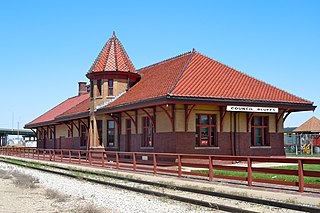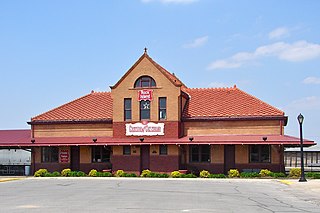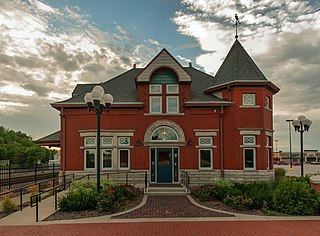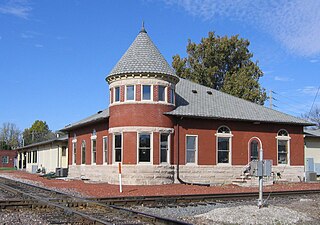
The Quad Cities is a region of cities in the U.S. states of Iowa and Illinois: Davenport and Bettendorf in southeastern Iowa, and Rock Island, Moline and East Moline in northwestern Illinois. These cities are the center of the Quad Cities metropolitan area, a region within the Mississippi River Valley, which as of 2013 had a population estimate of 383,781 and a Combined Statistical Area (CSA) population of 474,937, making it the 90th-largest CSA in the nation.

The Rock Island Depot and Freight House is a two-story railroad station and adjacent one-story freight house from the turn of the 20th century. It was constructed in 1899 directly besides the Illinois River in the American city of Peoria, Illinois. The depot and freight house are one of Peoria's last remaining historic reminders of the importance of passenger trains in the city's past, the other being the newer (1967) Rock Island station at 121 Morton Street now owned by the City of Peoria. The depot was built by the Chicago, Rock Island and Pacific Railroad as the terminus of a major branch line that delivered significant goods and passengers to Peoria. The 1900 opening of the depot was attended by "throngs of populous;" at its height before the depression of the 1880s, Peoria was a transportation hub. The station's clock tower was removed in 1939. The buildings were listed on the U.S. National Register of Historic Places in 1978. The last Rock Island train out of the station was the Peoria Rocket in 1978, of the company's Rock Island Rockets series.

Baton Rouge station is a historic train station located at 100 South River Road in downtown Baton Rouge, Louisiana. It was built for the Yazoo and Mississippi Valley Railroad which got absorbed by the Illinois Central Railroad. The station was a stop on the Y&MV main line between Memphis, Tennessee and New Orleans, Louisiana. The building now houses the Louisiana Art and Science Museum.

The Atchison, Topeka and Santa Fe Passenger and Freight Complex is a nationally recognized historic district located in Fort Madison, Iowa, United States. It was listed on the National Register of Historic Places in 1992. At the time of its nomination it contained three resources, all of which are contributing buildings. The buildings were constructed over a 24-year time period, and reflect the styles that were popular when they were built. The facility currently houses a local history museum, and after renovations a portion of it was converted back to a passenger train depot for Amtrak, which opened on December 15, 2021.

Charles Sumner Frost was an American architect. He is best known as the architect of Navy Pier and for designing over 100 buildings for the Chicago and North Western Railway.

The Chicago, Rock Island and Pacific Railroad Passenger Station is a historic building located in Iowa City, Iowa, United States. Built in 1898 for passenger use, it was the second depot in the city. The first one was built by the Mississippi and Missouri Railroad, a predecessor of the Chicago, Rock Island and Pacific Railroad (CRI&P), in 1855. This one was built through the efforts of Harry Breene, the local Rock Island agent. W.K. McFarlin, CRI&P's superintendent of maintenance and construction oversaw the building's construction. Architecturally, it is a combination of the Richardsonian Romanesque and Victorian Romanesque. The depot was built to similar designs of stations in Ottawa, Illinois, and Council Bluffs, Iowa.

The Crescent Warehouse Historic District is a 10.5-acre (4.2 ha) historic district in Downtown Davenport, Iowa, United States. The district is a collection of multi-story brick structures that formerly housed warehouses and factories. Most of the buildings have been converted into loft apartments. The district was listed on the National Register of Historic Places in 2003.

RailsWest Railroad Museum is a railroad museum operated by the Historical Society of Pottawattamie County at 16th Avenue and South Main Street and illustrates the history of railroads in Council Bluffs, Iowa.

The Burlington, Cedar Rapids and Northern Railway (BCR&N) was a railroad that operated in the United States from 1876 to 1903. It was formed to take over the operations of the bankrupt Burlington, Cedar Rapids and Minnesota Railway, which was, in turn, the result of merging several predecessor lines, the construction of which began in 1869. The corporate headquarters were in Cedar Rapids, Iowa, and it had operations in Iowa and in Minnesota. It was succeeded by the Chicago, Rock Island and Pacific Railway.

Union Station, also known as Union Station and Burlington Freight House, is located along the riverfront in downtown Davenport, Iowa, United States. It is listed on the National Register of Historic Places. The buildings are in a section of downtown with several historic structures. Across Ripley Street to the west is the Chicago, Milwaukee, St. Paul and Pacific Freight House, and to the east across Harrison Street is the Dillon Memorial. On River Drive northwest from the Burlington Freight House is The Linograph Company Building. Across Beiderbecke Drive to the south are the W.D. Petersen Memorial Music Pavilion and the Mississippi River.

The Burtis–Kimball House Hotel and the Burtis Opera House were located in downtown Davenport, Iowa, United States. The hotel was listed on the National Register of Historic Places in 1979. It has since been torn down and it was delisted from the National Register in 2008. The theatre building has been significantly altered since a fire in the 1920s. Both, however, remain important to the history of the city of Davenport.
Frost & Granger was an American architectural partnership from 1898 to 1910 of brothers-in-law Charles Sumner Frost (1856–1931) and Alfred Hoyt Granger (1867–1939). Frost and Granger were known for their designs of train stations and terminals, including the now-demolished Chicago and North Western Terminal, in Chicago. The firm designed several residences in Hyde Park, Illinois, and many other buildings. Several of their buildings are listed on the U.S. National Register of Historic Places.

Chicago, Rock Island and Pacific Railroad-Wilton Depot is an historic building located in Wilton, Iowa, United States. The Mississippi and Missouri Railroad built the first rail line in 1855 in what would be called Wilton Junction. The railroad became the Chicago, Rock Island and Pacific Railroad (CRI&P) a few years later. A wooden frame depot and a separate freight facility served the community. The railroad placed their repair and maintenance center in Wilton, and it remained here until 1881 when they started to move operations to Davenport and Muscatine. Rail service continued to increase along the CRI&P, which necessitated a new depot in Wilton. This single-story, brick Romanesque Revival structure was completed in 1898. Six passenger trains stopped in Wilton in 1911, and by 1922 same-day service to and from Chicago began.

Keokuk Union Depot is a historic train station on the west bank of the Mississippi River near downtown Keokuk, Iowa, United States. It was built from 1890 to 1891, and it was listed on the National Register of Historic Places in 2013.

The Chicago, Rock Island & Pacific Railroad Depot, also known as the Rock Island Depot, is an historic building located in Atlantic, Iowa, United States. The Chicago, Rock Island & Pacific Railroad built the first tracks through the area in 1868. The city of Atlantic was founded at the time of the railroad construction. It grew to become the largest and the most significant community along the Rock Island lines between Des Moines and Council Bluffs. The present depot dates from 1898, and it is not a standard-plan depot for the railroad. The unusual design suggests it is the work of an architect, possibly from Chicago. It was built during a prosperous period for the railroad when it was able to replace its facilities along its mainline. The express freight and baggage building attached to the depot was built at the same time. The passenger depot replaced a frame combination passenger and freight depot a block away.

The Chicago & Northwestern Passenger Depot and Baggage Room-Carroll, also known as the Carroll Depot is a historic building located in Carroll, Iowa, United States. It is an example of a replacement station built along its Iowa mainline by the Chicago and North Western Railway (CNW) in 1896. It replaced a two-story, frame, combination station that was first built in 1867 by its predecessor line, the Cedar Rapids and Missouri River Railroad. That building had experienced two fires. The CNW had built two branch lines from Carroll in 1877 and 1880, which increased business and necessitated a larger depot. The Carroll Express Building was also built across the street for further railroad use. A separate wooden freight house had been built in 1888. Chicago architect Charles Sumner Frost designed this station in the Romanesque Revival style. The baggage room is separated from the depot by a breezeway. Frost designed at least 15 stations for the CNW in Iowa and Nebraska and another 14 in the Chicago area. The building represents the prosperity of the line during the Golden Age of Railroads.

Union Depot, also known as the Grinnell Union Depot, is an historic building located in Grinnell, Iowa, United States. The Chicago, Rock Island & Pacific Railroad built the first tracks through the area in 1863, and they built a simple frame depot the same year. The Central Railroad of Iowa extended its north–south line to Grinnell nine years later, and their tracks crossed the Rock Island tracks at this location. The Minneapolis and St. Louis Railway eventually acquired the Central Railroad. The old depot became too small and this one replaced it in 1893. It was designed by the Rock Island Lines and built by a local contractor. The one-story, brick structure follows a square plan with a round corner tower at the junction of the two tracks. The tower provided the station agent with a clear view in all directions.

The Chicago, Rock Island and Pacific Passenger Depot-Pella, also known as the Pella Depot and the Rolscreen Museum, is a historic building located in Pella, Iowa, United States. The Des Moines Valley Railroad built the first tracks through the area in 1865, and they built a simple frame depot to serve passenger's needs. For 10 years, Pella served as the only rail stop in Marion County until a competing station was built in Knoxville, Iowa by the Chicago, Burlington, and Quincy Railroad. The Chicago, Rock Island & Pacific Railroad leased the Des Moines Valley's tracks beginning in 1878 and provided freight service through 1980. The old frame building was replaced, in 1906, with a single story, brick depot–a conventional building style for the railroad. The new, brick depot served as a passenger station until the latter 1940s. The last passenger service was as a stop on a short line motor train service between Eldon in southeast Iowa and Des Moines. The station was freight only by 1949.

The Davenport Downtown Commercial Historic District is a nationally recognized historic district located in the central business district of Davenport, Iowa, United States. It was listed on the National Register of Historic Places in 2020. At the time of its nomination it consisted of 43 resources, which included 33 contributing buildings, one contributing structure, and nine non-contributing buildings. In addition, the district also contains 33 buildings that are individually listed on the National Register. This historic district is bordered by four other districts: the Crescent Warehouse Historic District and the Davenport Motor Row and Industrial Historic District on the east, the Hamburg Historic District to the northwest, and the West Third Street Historic District on the west.

The Des Moines Rock Island Depot is a combination passenger and freight pair of buildings in the Beaux-Arts style in downtown Des Moines, Iowa. Construction of the Chicago, Rock Island and Pacific Railroad passenger building was completed in 1901. The building is in the Civic Center Historic District, west of the Des Moines River. A covered freight platform and brick building added in 1910 on the east side of the pair of buildings.






















